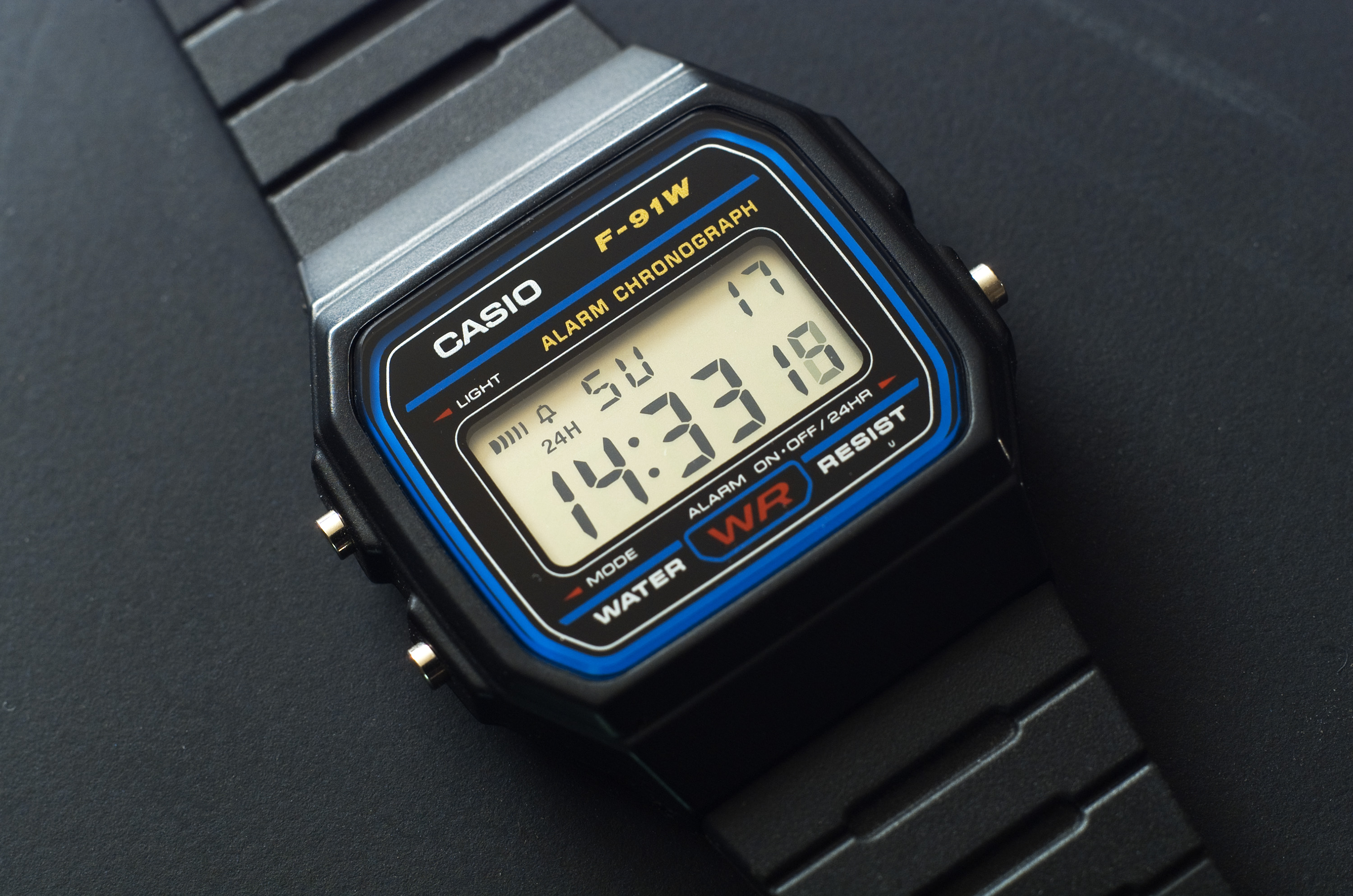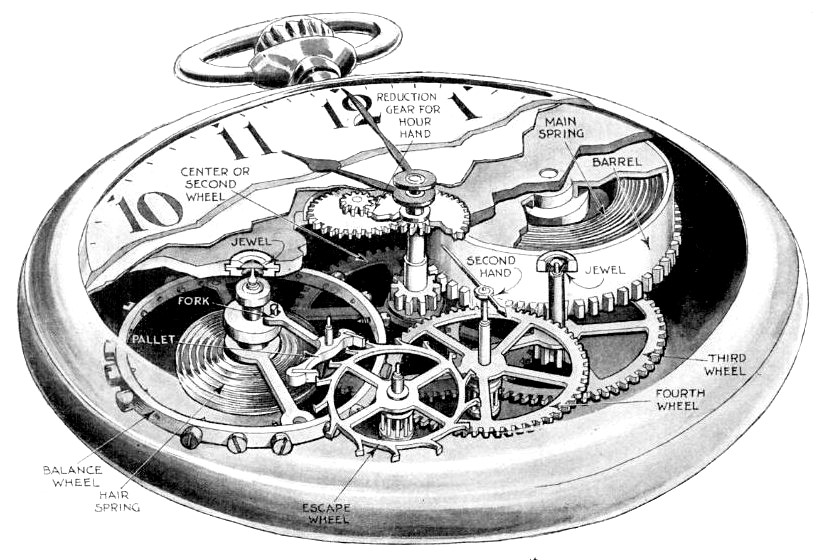|
Barrel (horology)
Used in mechanical watches and clocks, a barrel is a cylindrical metal box closed by a cover, with a ring of gear teeth around it, containing a spiral spring called the mainspring, which provides power to run the timepiece. The barrel turns on an arbor (axle). The spring is hooked to the barrel at its outer end and to the arbor at its inner end. The barrel teeth engage the first pinion of the wheel train of the watch, usually the center wheel.{{Cite book , last=Hood , first=Grant , url=https://books.google.com/books?id=1UQxAQAAMAAJ , title=Modern Methods in Horology , date=1904 , publisher=Kansas City Jeweler and Optician , pages=44 , language=en Barrels rotate slowly: for a watch mainspring barrel, the rate is usually one rotation every 8 hours. This construction allows the mainspring to be wound (by turning the arbour) without interrupting the tension of the spring driving the timepiece. Types ; Plain barrel: I.e. without teeth, used in fusee watches and clocks. A chain, ... [...More Info...] [...Related Items...] OR: [Wikipedia] [Google] [Baidu] |
Watch Mainspring Barrel
A watch is a timepiece carried or worn by a person. It is designed to maintain a consistent movement despite the motions caused by the person's activities. A wristwatch is worn around the wrist, attached by a watch strap or another type of bracelet, including metal bands or leather straps. A pocket watch is carried in a pocket, often attached to a chain. A stopwatch is a type of watch that measures intervals of time. During most of their history, beginning in the 16th century, watches were mechanical devices, driven by clockwork, powered by winding a mainspring, and keeping time with an oscillating balance wheel. These are known as ''mechanical watches''. In the 1960s the electronic ''quartz watch'' was invented, powered by a battery and keeping time with a vibrating quartz crystal. By the 1980s it had taken over most of the watch market, in what became known as the quartz revolution (or the quartz crisis in Switzerland, whose renowned watch industry it decimated). In th ... [...More Info...] [...Related Items...] OR: [Wikipedia] [Google] [Baidu] |
Mechanical Watch
A mechanical watch is a watch that uses a Movement (clockwork), clockwork mechanism to measure the passage of time, as opposed to quartz watches which function using the vibration modes of a piezoelectric quartz tuning fork, or radio clock, radio watches, which are quartz watches synchronized to an atomic clock via radio waves. A mechanical watch is driven by a mainspring which must be wound either periodically by hand or via a Automatic watch, self-winding mechanism. Its force is transmitted through a series of gears to power the balance wheel, a weighted wheel which oscillates back and forth at a constant rate. A device called an escapement releases the watch's wheels to move forward a small amount with each swing of the balance wheel, moving the watch's hands forward at a constant rate. The escapement is what makes the 'ticking' sound which is heard in an operating mechanical watch. Mechanical watches evolved in Europe in the 17th century from spring powered clocks, which appe ... [...More Info...] [...Related Items...] OR: [Wikipedia] [Google] [Baidu] |
Clock
A clock or chronometer is a device that measures and displays time. The clock is one of the oldest Invention, human inventions, meeting the need to measure intervals of time shorter than the natural units such as the day, the lunar month, and the year. Devices operating on several physical processes have been used over the Millennium, millennia. Some predecessors to the modern clock may be considered "clocks" that are based on movement in nature: A sundial shows the time by displaying the position of a shadow on a flat surface. There is a range of duration timers, a well-known example being the hourglass. Water clocks, along with sundials, are possibly the oldest time-measuring instruments. A major advance occurred with the invention of the verge escapement, which made possible the first mechanical clocks around 1300 in Europe, which kept time with oscillating timekeepers like balance wheels., pp. 103–104., p. 31. Traditionally, in horology (the study of timekeeping), the ... [...More Info...] [...Related Items...] OR: [Wikipedia] [Google] [Baidu] |
Mainspring
A mainspring is a spiral torsion spring of metal ribbon—commonly spring steel—used as a power source in mechanical watches, some clocks, and other clockwork mechanisms. ''Winding'' the timepiece, by turning a knob or key, stores energy in the mainspring by twisting the spiral tighter. The force of the mainspring then turns the clock's wheels as it unwinds, until the next winding is needed. The adjectives wind-up and spring-powered refer to mechanisms powered by mainsprings, which also include kitchen timers, metronomes, music boxes, wind-up toys and clockwork radios. Modern mainsprings A modern watch mainspring is a long strip of hardened and blued steel, or specialised steel alloy, 20–30 cm long and 0.05-0.2 mm thick. The mainspring in the common 1-day movement is calculated to enable the watch to run for 36 to 40 hours, i.e. 24 hours between daily windings with a power-reserve of 12 to 16 hours, in case the owner is late winding the watch. This is the no ... [...More Info...] [...Related Items...] OR: [Wikipedia] [Google] [Baidu] |
Pinion
A pinion is a round gear—usually the smaller of two meshed gears—used in several applications, including drivetrain and rack and pinion systems. Applications Drivetrain Drivetrains usually feature a gear known as the pinion, which may vary in different systems, including * the typically smaller gear in a gear drive train (although in the first commercially successful steam locomotive—the ''Salamanca''—the ''pinion'' was rather large). In many cases, such as remote controlled toys, the pinion is also the drive gear for a reduction in speed, since electric motors operate at higher speed and lower torque than desirable at the wheels. However the reverse is true in watches, where gear trains commence with a high-torque, low-speed spring and terminate in the fast-and-weak escapement. * the smaller gear that drives in a 90-degree angle towards a crown gear in a differential drive. * the small front sprocket on a chain driven motorcycle. *the clutch bell gear when pai ... [...More Info...] [...Related Items...] OR: [Wikipedia] [Google] [Baidu] |
Wheel Train (horology)
In horology, a wheel train (or just train) is the gear train of a mechanical watch or clock. Although the term is used for other types of gear trains, the long history of mechanical timepieces has created a traditional terminology for their gear trains which is not used in other applications of gears. Watch movements are very standardized, and the wheel trains of most watches have the same parts. The wheel trains of clocks are a little more varied, with different numbers of wheels depending on the type of clock and how many hours the clock runs between windings (the "going"). However, the wheel trains of clocks and watches share the same terminology, and are similar enough that they can be described together. The large gears in timepieces are generally called ''wheels'', the smaller gears they mesh with (large to small, large to small) are called pinions, and the shafts that the wheels and pinions are mounted on are called ''arbors''. The wheels are mounted between the plate ... [...More Info...] [...Related Items...] OR: [Wikipedia] [Google] [Baidu] |
Fusee (horology)
A fusee (from the French ''fusée'', wire wound around a spindle) is a cone (geometry), cone-shaped pulley with a helical groove around it, wound with a cord or chain attached to the mainspring Barrel (horology), barrel of antique mechanical watches and clocks. It was used from the 15th century to the early 20th century to improve timekeeping by equalizing the uneven pull of the mainspring as it ran down. The watch and clock historian Granville Hugh Baillie stated of the fusee, "Perhaps no problem in mechanics has ever been solved so simply and so perfectly." History The origin of the fusee is not known. Many sources erroneously credit clockmaker Jacob Zech of Prague with inventing it around 1525. The earliest definitely dated fusee clock was made by Zech in 1525, but the fusee actually appeared earlier, with the first spring driven clocks in the 15th century., p.127-128, p.121 The idea probably did not originate with clockmakers, since the earliest known example is in a cross ... [...More Info...] [...Related Items...] OR: [Wikipedia] [Google] [Baidu] |
Jean-Antoine Lépine
Jean-Antoine Lépine (; alternatively spelled L’Pine, LePine, Lepine, L’Epine, born Jean-Antoine Depigny; 18 November 1720 – 31 May 1814) was a French watchmaker. He contributed inventions which are still used in watchmaking today and was amongst the finest French watchmakers, who were contemporary world leaders in the field. Beginnings and appointment as clockmaker to the King Since his childhood the horologist showed an inclination towards mechanical, beginning his horological career and making fast progress, in particular, under the direction of Mr. Decroze, manufacturer of Saconnex watches, in the suburbs of Geneva (Switzerland). He moved to Paris in 1744 when he was 24 years of age, serving as apprentice to André-Charles Caron (1698–1775), at that time clockmaker to Louis XV. In 1756 he married Caron's daughter and associated with him, under "Caron et Lépine", between 1756 and 1769. [...More Info...] [...Related Items...] OR: [Wikipedia] [Google] [Baidu] |
Pocket Watch
A pocket watch is a watch that is made to be carried in a pocket, as opposed to a wristwatch, which is strapped to the wrist. They were the most common type of watch from their development in the 16th century until wristwatches became popular after World War I during which a transitional design, trench watches, were used by the military. Pocket watches generally have an attached chain to allow them to be secured to a waistcoat, lapel, or belt loop, and to prevent them from being dropped. Watches were also mounted on a short leather strap or fob, when a long chain would have been cumbersome or likely to catch on things. This fob could also provide a protective flap over their face and crystal. Women's watches were normally of this form, with a watch fob that was more decorative than protective. Chains were frequently decorated with a silver or enamel pendant, often carrying the arms of some club or society, which by association also became known as a fob. Ostensibly practi ... [...More Info...] [...Related Items...] OR: [Wikipedia] [Google] [Baidu] |
Gear Train
A gear train or gear set is a machine element of a mechanical system formed by mounting two or more gears on a frame such that the teeth of the gears engage. Gear teeth are designed to ensure the pitch circles of engaging gears roll on each other without slipping, providing a smooth transmission of rotation from one gear to the next. Features of gears and gear trains include: * The gear ratio of the pitch circles of mating gears defines the speed ratio and the mechanical advantage of the gear set. * A planetary gear train provides high gear reduction in a compact package. * It is possible to design gear teeth for gears that are non-circular, yet still transmit torque smoothly. * The speed ratios of chain and belt drives are computed in the same way as gear ratios. See bicycle gearing. The transmission of rotation between contacting toothed wheels can be traced back to the Antikythera mechanism of Greece and the south-pointing chariot of China. Illustrations by the Renaissan ... [...More Info...] [...Related Items...] OR: [Wikipedia] [Google] [Baidu] |






